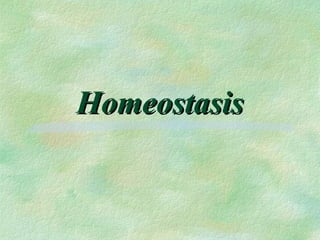
Homeostasis
- 1. Homeostasis
- 2. An overview of anatomy and physiology Anatomy is the study of body structures and their relationships; physiology is the science of how body parts function.
- 3. Topics of physiology Typically, physiology concerns the functioning of specific organs or organ systems. Examples include cardiac physiology, renal physiology, and muscle physiology. Physiology is explained by chemical and physical principles.
- 4. Complementarity of structure and function Anatomy and physiology are inseparable: What a body can do depends on the unique architecture of its parts. This is called the complementarity and function.
- 5. The hierarchy of structural organization The levels of structural organization of the body, from simplest to most complex, are: chemical, cellular, tissue, organ, organ system, and organismal.
- 6. The hierarchy of structural organization The 11 organ systems of the body are the integumentary, skeletal, muscular nervous, endocrine, cardiovascular, lymphatic, respiratory, digestive, urinary, and reproductive systems. The immune system is a functional system closely associated with the lymphatic system.
- 8. Functional characteristics All living organisms carry out certain vital functional activities necessary for life, including maintenance of boundaries, movement, responsiveness, digestion, metabolism, excretion, reproduction, and growth.
- 9. Survival needs Survival needs include nutrients, water, oxygen, appropriate body temperature, and atmospheric pressure.
- 10. Homeostasis Homeostasis is a dynamic equilibrium of the internal environment. All body systems contribute to homeostasis, but the nervous and endocrine systems are most important.
- 11. General characteristics of control mechanisms Control systems of the body contain at least three elements: receptor(s), control center, and effector(s).
- 12. Negative feedback mechanisms Negative feedback mechanisms reduce the original stimulus, and are essential for maintaining homeostasis. Body temperature, heart rate, breathing rate and depth, and blood levels of glucose and certain ions are regulated by negative feedback mechanisms.
- 13. Positive feedback mechanisms Positive feedback mechanisms intensify the initial stimulus leading to an enhancement of the response. Positive feedback mechanisms rarely contribute to homeostasis, but blood clotting and labor contractions are regulated by such mechanisms.
- 14. Homeostatic imbalance With age, the efficiency of negative feedback mechanisms declines, and positive feedback mechanisms occur more frequently. These changes underlie certain disease conditions.